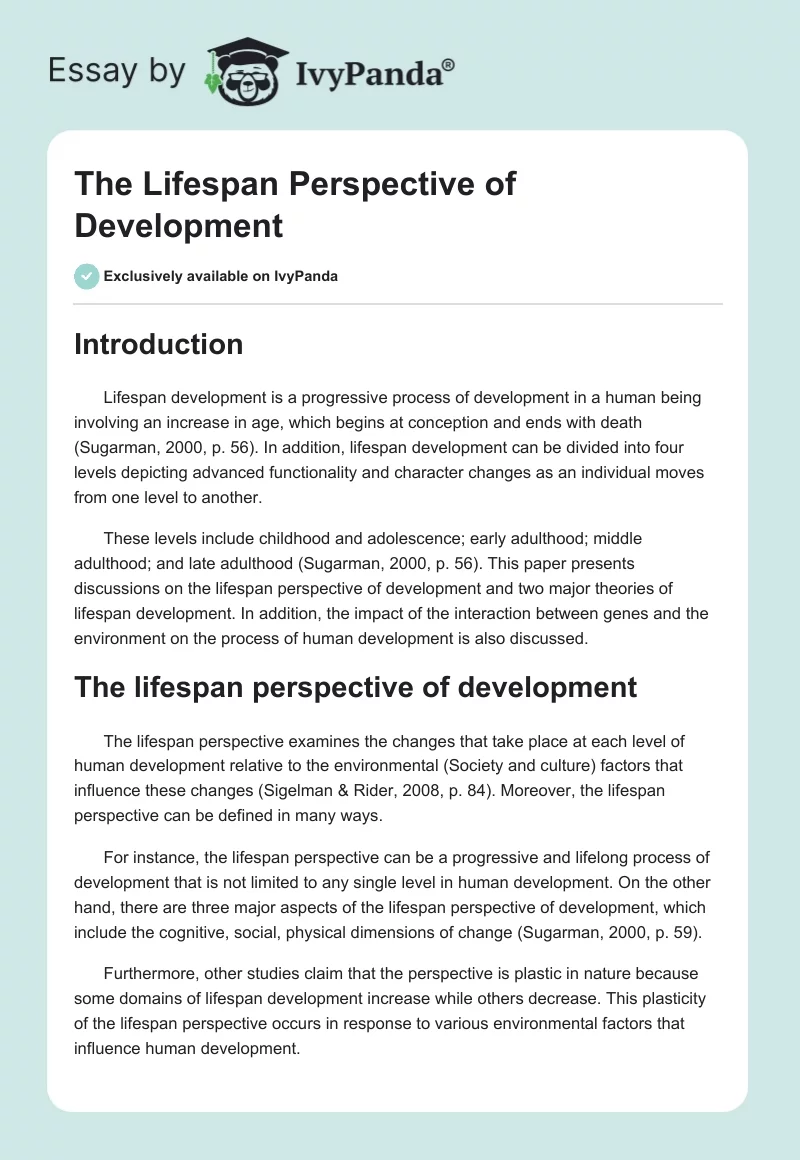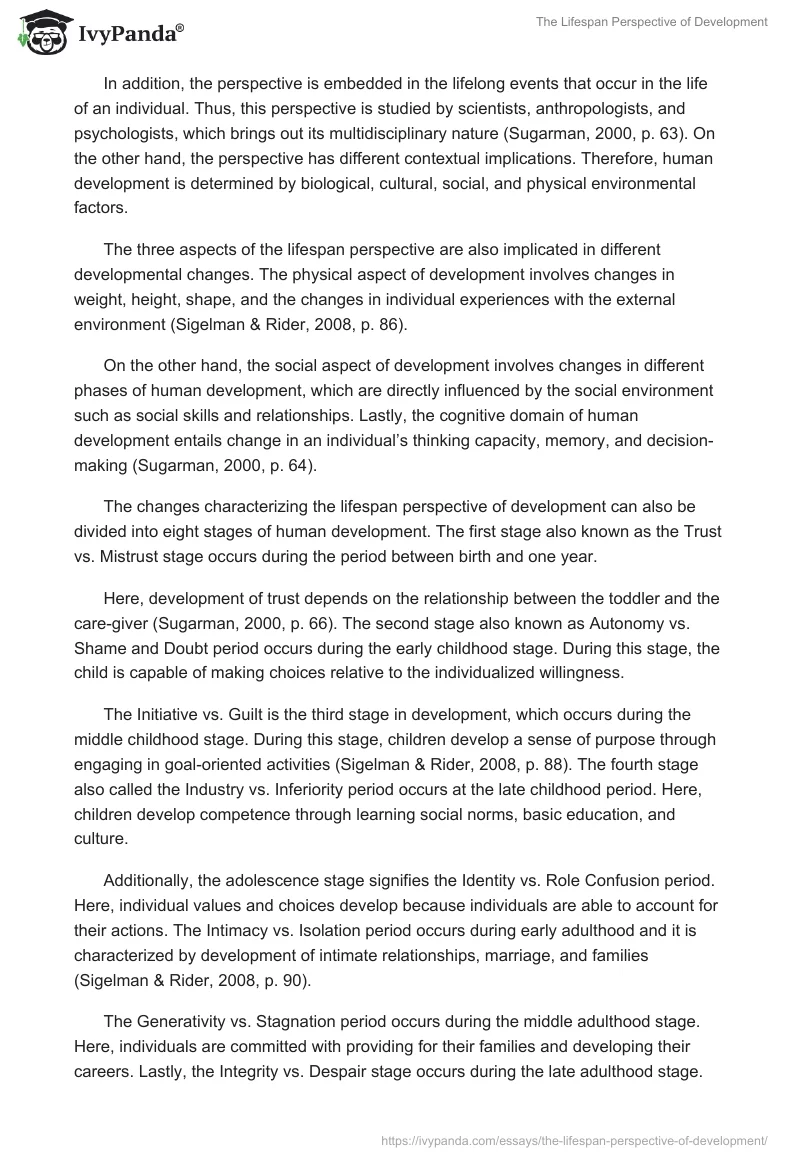Introduction
Lifespan development is a progressive process of development in a human being involving an increase in age, which begins at conception and ends with death (Sugarman, 2000, p. 56). In addition, lifespan development can be divided into four levels depicting advanced functionality and character changes as an individual moves from one level to another.
These levels include childhood and adolescence; early adulthood; middle adulthood; and late adulthood (Sugarman, 2000, p. 56). This paper presents discussions on the lifespan perspective of development and two major theories of lifespan development. In addition, the impact of the interaction between genes and the environment on the process of human development is also discussed.
The lifespan perspective of development
The lifespan perspective examines the changes that take place at each level of human development relative to the environmental (Society and culture) factors that influence these changes (Sigelman & Rider, 2008, p. 84). Moreover, the lifespan perspective can be defined in many ways.
For instance, the lifespan perspective can be a progressive and lifelong process of development that is not limited to any single level in human development. On the other hand, there are three major aspects of the lifespan perspective of development, which include the cognitive, social, physical dimensions of change (Sugarman, 2000, p. 59).
Furthermore, other studies claim that the perspective is plastic in nature because some domains of lifespan development increase while others decrease. This plasticity of the lifespan perspective occurs in response to various environmental factors that influence human development.
In addition, the perspective is embedded in the lifelong events that occur in the life of an individual. Thus, this perspective is studied by scientists, anthropologists, and psychologists, which brings out its multidisciplinary nature (Sugarman, 2000, p. 63). On the other hand, the perspective has different contextual implications. Therefore, human development is determined by biological, cultural, social, and physical environmental factors.
The three aspects of the lifespan perspective are also implicated in different developmental changes. The physical aspect of development involves changes in weight, height, shape, and the changes in individual experiences with the external environment (Sigelman & Rider, 2008, p. 86).
On the other hand, the social aspect of development involves changes in different phases of human development, which are directly influenced by the social environment such as social skills and relationships. Lastly, the cognitive domain of human development entails change in an individual’s thinking capacity, memory, and decision-making (Sugarman, 2000, p. 64).
The changes characterizing the lifespan perspective of development can also be divided into eight stages of human development. The first stage also known as the Trust vs. Mistrust stage occurs during the period between birth and one year.
Here, development of trust depends on the relationship between the toddler and the care-giver (Sugarman, 2000, p. 66). The second stage also known as Autonomy vs. Shame and Doubt period occurs during the early childhood stage. During this stage, the child is capable of making choices relative to the individualized willingness.
The Initiative vs. Guilt is the third stage in development, which occurs during the middle childhood stage. During this stage, children develop a sense of purpose through engaging in goal-oriented activities (Sigelman & Rider, 2008, p. 88). The fourth stage also called the Industry vs. Inferiority period occurs at the late childhood period. Here, children develop competence through learning social norms, basic education, and culture.
Additionally, the adolescence stage signifies the Identity vs. Role Confusion period. Here, individual values and choices develop because individuals are able to account for their actions. The Intimacy vs. Isolation period occurs during early adulthood and it is characterized by development of intimate relationships, marriage, and families (Sigelman & Rider, 2008, p. 90).
The Generativity vs. Stagnation period occurs during the middle adulthood stage. Here, individuals are committed with providing for their families and developing their careers. Lastly, the Integrity vs. Despair stage occurs during the late adulthood stage. The elderly individuals are self-contented and they are full of life experiences and advice.
Theories of Lifespan Development
There are many theories that attempt to explain the process of human development from different perspectives such as Freud’s theory of psychosexual development and Erikson’s theory on psychosocial development. Erikson’s theory posits that an individual encounters several conflicts during the development process, which depend on the type of relationship existing between this individual and the society.
Therefore, as an individual moves through the eight stages of development discussed above, he/she must solve the conflicts involved in one stage before moving to another. This ensures that one develops a sound personality; otherwise one may encounter difficulties in addressing conflicts in subsequent stages if the previous ones were not sufficiently resolved (Sugarman, 2000).
On the other hand, Freud’s theory states that the process of personality development occurs at the early childhood stage. Subsequently, the behavioral changes observed in developing individuals are influenced by the childhood events. Here, personality development occurs through several stages during the early childhood stage.
During this stage, the pleasure-oriented capabilities of an individual become focused on specific areas in one’s body. These capabilities also known as sexual libido or psychosexual energy play a major role in the subsequent behavioral changes in an individual (Sigelman & Rider, 2008).
Thus, if all the issues involved in the psychosexual stages of development are adequately resolved, then an individual develops a sound personality. However, if the psychosexual issues remain unresolved, the person involved is trapped in a particular stage until all the issues are resolved.
The Interaction of Genes and the Environment in Lifespan Development
A child inherits the genetic information of both parents through the information carriers known as genes. The genes are made up of DNA, which is found on chromosomes. On the other hand, the environment in the context of lifespan development refers to the total social and cultural factors surrounding a developing human being (Sigelman & Rider, 2008, p. 86). Therefore, lifespan development in children depends on two major factors; the genetic make-up of a child and the environmental factors.
However, the two factors can play a mutual role in influencing the development of different individuals in the society. Here, the epigenetic framework of development posits that the genetic make-up can be turned on and off relative to the internal and external environmental feedback (Sigelman & Rider, 2008, p. 89).
This gives the process of lifespan development the flexibility and plasticity described in the discussions above. For instance, the learning process in children follows a specific pattern of adaptability, which depends on the internal and external factors.
Therefore, during the early childhood stage, individuals use the environmental experiences in reasoning and acting. However, as the environmental factors and experiences change along the period of lifespan development, so does the emotional, reasoning, and social attributes in an individual (Sigelman & Rider, 2008, p. 91).
Conclusions
The paper presents discussions on the lifespan perspective of development, the theories of lifespan development and the interaction of heredity and environment to produce individual differences in development.
From the discussions above, the lifespan perspective of development examines the changes that occur in different individuals, which occur due to the interaction of the genetic make-up and the total circumstances surrounding an individual. On the other hand, this perspective is also reinforced by Freud’s theory of psychosexual development and Erikson’s theory of psychosocial development, which are summarized in the discussions above.
Reference List
Sigelman, C. K. & Rider, E. A. (2008). Lifespan human development. New York: Cengage Learning Publishers, Inc.
Sugarman, L. (2000). Lifespan development: Frameworks, accounts and strategies (2nd ed.). New York: Routledge.


